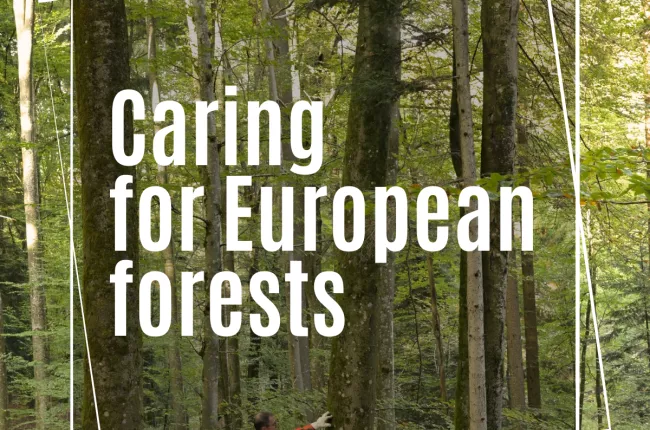When discussing nature credits on an EU level, the Confederation of European Forest Owners (CEPF) sees the potential for rewarding biodiversity safeguard, nature conservation and maintenance, and opening up new income opportunities for forest owners. However, CEPF finds it imperative to take sufficient time to develop a good clear basis that enables the potential framework to be implementable and attractive.
A nature credits framework should support forest owners in implementing measures to maintain and increase biodiversity in European forests. Thus, if aiming to design a nature credits framework that is implementable and a market that is attractive, the approach must include close cooperation with European forest owners throughout the process. As there is no functional one-size-fits-all approach to European forests, there can be no one-size-fits-all approach to the way forests contribute to maintaining and increasing biodiversity.
Forest owners are in a key role when it comes to voluntary measures in boosting biodiversity, and thus CEPF would like to emphasise the following points that support forest owners’ participation:
For this, CEPF has four main recommendations to work on:
- Multifunctionality of forests
- Voluntary and market-based framework
- Sensible approach to offsetting
- Leakage prevention
- Sensible relations to other policies
1. Multifunctionality of forests
Sustainable forest management relies on complex, integrated and long-term decisions that aim at ensuring multifunctionality. Reaching multifunctionality means that biodiversity protection and regulating ecosystem services, such as water retention and purification, cannot and should not be disconnected from the other services provided by forests. Therefore, nature credits should be seen as a possible added value, not as an approach favouring single objective to manage forests. Generating revenue from biodiversity and regulating ecosystem services while maintaining timber production allows for diversification that reduces economic risks. This enables more flexible forest management approaches that can optimise for both biodiversity and economic outcomes over longer time horizons.
Although nature credits might focus on biodiversity measures and some specific ecosystem services in forests, the EU policy preparation should consider holistic and multifunctional use of forests. This is even more important at a time when EU forests must be seen as a strategic asset to strengthen EU autonomy, resilience, and security. Therefore, the potential future market should allow additionality on biodiversity to be reached simultaneously with wood production and enhancing jobs in rural areas.
A successful nature credits framework must support, rather than override, the multifunctional role of forests by recognising the diverse contributions of forests to society.
2. A realistic voluntary and market-based framework
A nature credits framework is a supplementary tool to finance nature. It should be voluntary and market-based so as to allow an adequate balance of demand and supply while taking into account regional differences. When a government or another public entity imposes restrictions, fair and timely compensation should come from public funds as stated by Article 17 of EU Charter of Fundamental Rights.
Moreover, voluntariness and continuity of previous work need to be prioritised. It is important to ensure that any possible EU-level nature credit framework does not prevent initiatives already established in Member States or specific regions from continuing their work. The EU can support the development of nature credits market in many ways (e.g. sharing best practices) on a voluntary basis while still allowing different approaches in different Member States. The possible need to fully harmonise nature credits and their market within the EU should be extremely carefully analysed.
This being said, it takes many years to develop a successful market, and demands should not be overestimated. Policies based on over-optimistic assumptions could weaken confidence and participation in voluntary, market-based schemes.
Furthermore, it is in the best interest of all actors to not allow greenwashing. Thus, understandably there is demand for approaches based on third-party quality control. These approaches can include e.g. a defined unit and an official register for the units. However, there must also be space for biodiversity-focused projects and measures that do not seek verification, although they may also benefit from a potentially emerging nature credits market.
A grounded, flexible approach that acknowledges current economic conditions and respects early adopters is essential to build trust and long-term engagement in any future nature credits market.
3. Sensible approach to offsetting
While acknowledging the non-fungible nature of ecosystems, CEPF recognises that offsetting mechanisms can serve as crucial demand generators for viable nature credits markets. Although offsetting must not become a loophole that undermines the credibility of the nature credits framework, it may offer prospective benefits of attracting additional interest and financing from the private sector. If offsetting is to be part of the framework, it should be only permitted on the level of individual Member States, and consequently, left to them to regulate. A uniform EU-level mechanism could not necessarily respect national circumstances and diverse ecological conditions across the continent.
Offsetting can enhance economic efficiency by allowing efforts to be strategically targeted where forest owners can deliver optimal outcomes. Like-for-like compensation and geographic proximity should be required to ensure ecological integrity is maintained. CEPF supports enabling offsetting within Member States, provided it is governed soundly to prevent greenwashing and promote genuine ecological gains. A well-designed mechanism can mobilise private capital for biodiversity and make nature credits an economically viable option for European forest owners while supporting the integrity of nature credits markets.
Offsetting must be recognised as a legitimate and necessary tool within the broader framework of nature credits.
4. Leakage prevention
Leakage is extremely difficult to control especially in a global market. In case the nature credit market takes such prevalence that it affects the amount of harvesting in Europe, wood would have to be imported from third countries. A negative impact on EU production would lead to an income transfer with questionable biodiversity benefits and put the EU wood value chains and its benefits to EU society at risk.
Possible measures to address this could include increased wood mobilisation, and an emphasis on nature credits-generating measures that still allow simultaneous wood production. A best-case scenario includes nature credits actually contributing to wood mobilisation directly by making forest management and wood harvesting profitable in areas where it previously wasn’t.
A robust domestic offsetting market can help prevent leakage by maintaining economic incentives for European forest management. When forest owners can generate competitive revenues from nature credits through offsetting demand, they are less likely to cease active management. This creates a positive feedback loop where offsetting demand supports continued European forest stewardship.
To avoid unintended negative impacts, the nature credits framework should support measures that align biodiversity improvement with continued sustainable wood production and forest management.
5. Sensible relations to other policies
Coinciding with the EU’s simplification goals, the nature credit framework should also be simple enough. A simple approach would allow a large number of forest owners in different parts of the Europe to participate.
In terms of simplification, CEPF does not see a functional link between the carbon removals certification framework (CRCF) and nature credits, nor does it call for it. From the forest owners' perspective, keeping carbon and nature credit systems clearly separate helps maintain clarity. Although these markets have obvious similarities, and the nature credits and their markets are taking a lot of inspiration from carbon credits and markets, CEPF does not find combining them useful. There can be biodiversity projects that don’t benefit climate mitigation, and carbon projects that don’t particularly benefit biodiversity, although a biodiversity co-benefit is currently required under CRCF. Additionally, with the do no significant harm criteria, we see that these different kinds of projects can ensure a clear net benefit, even if not on multiple fronts at the same time.
The closer-to-nature forestry approach, developed by the European Commission, is not comprehensive enough nor suitable for the diversity of European forests to be the sole approach through which forest management should be included and eligible for nature credits. Seeing the increasing emphasis on closer-to-nature forestry practices, CEPF reiterates the limited scope that this approach is able to provide. Other methods of biodiversity-increasing activities provided through forest management need to be included.
Given their differing objectives and expected outcomes, the potential nature credit framework should remain distinct from carbon markets and flexible enough to reflect the diversity of forests and their management practices across Europe.




